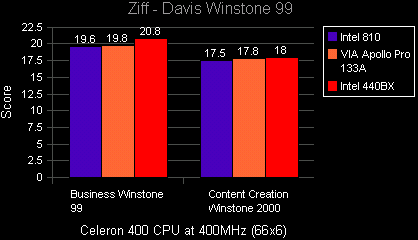Though I did get a memory upgrade recently, upping the total to 160MB, only
96MB was used in order to keep constant the test bed setup used in performance
testing of motherboards reviewed in the past. Here are some more details of the
hardware used to put the Asus P3B-F to the test...
System
Configuration
Celeron 400 CPU
Asus P3B-F 440BX
Motherboard
Soltek SL-02A++ Slocket Adapter
96MB PC100 SDRAM
(CAS-2)
8.4GB Quantum Fireball CR
2 other motherboards were used to
compare the Asus P3B-F with. These are...
- Azza PT-810DMC based upon the
Intel 810 chipset
- Soltek SL-67KV based upon the VIA Apollo Pro 133A chipset
(used with the Soltek SL-02A++ Slocket Adapter)
Winstone
Performance
For this benchmark, Winstone 99 and Content Creation Winstone
2000 have been used to test the overall performance of the test bed setup.
Winstone 99 (Business Winstone 99) v1.2 is used to test the overall business
performance of the computer system by using applications such as MS Office 97,
Lotus Smartsuite 97, etc. Content Creation Winstone 2000 is a system-level,
application-based benchmark that measures a PC's overall performance when
running today's Windows-based Internet content creation applications. The test
focuses on top-selling Internet content creation applications.
Each test
was run 3 times with the result being the average value of the 3 test runs.
Higher numbers indicate better performance.
The first graph displayed
shows the performance of the Celeron 400 CPU clocked in at its rated speed of
400MHz. The second graph below indicates performance of the 3 boards operating
with an overclocked Celeron 400 at 83x6, or 500MHz.


Performance
Analysis
Well here are the results. As you
can clearly see, the Intel 440BX-based motherboard outperforms a similarly configured Intel 810 and VIA Apollo Pro
133A based offerings. By looking at both graphs, we can see that the
performance differences between the 440BX and other boards are more pronounced at the higher clock speed
of 500MHz.
Of course, these results are still in the
preliminary stages as only two competitors are staged against the Asus P3B-F and
shouldn't be taken as final. The point of this was to emphasize the point that
although the BX has aged quite a bit, it still performs just as well (better in
this case) as newer chipset designs that emerge from manufacturer's
labs.
Yeah,
fine! But exactly how stable is it? I think that it is well established fact
that BX based boards are rock solid. Nevertheless, I had the pleasure of
verifying that for myself, and for you as well! ;) So let's move on, shall
we?
